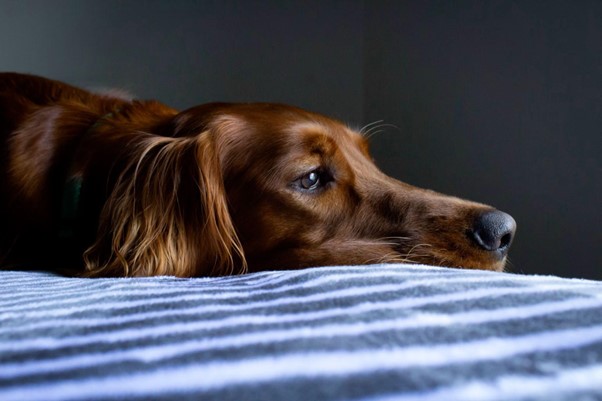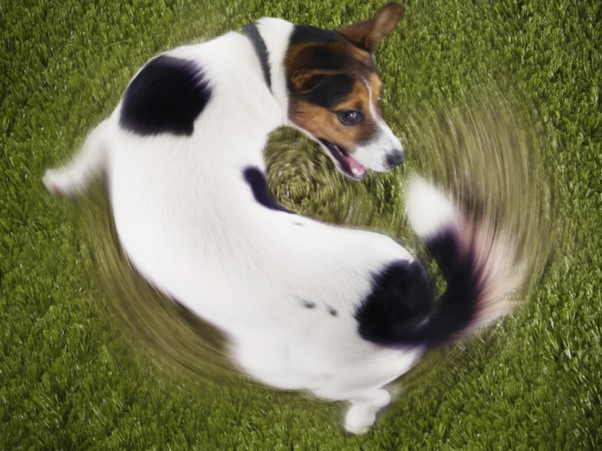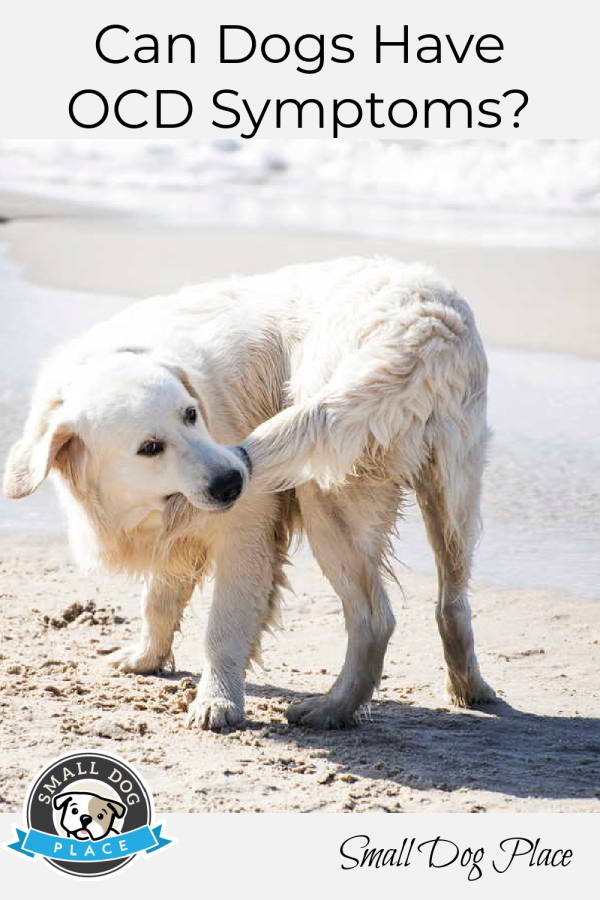- Small Dog Place Home
- Emotional Problems
- Can Dogs Have OCD Symptoms
Can Dogs Have OCD Symptoms?
Can Dogs Have OCD Symptoms? Provided by
Impulse Therapy |Published 07-27-2022
Does your dog bark constantly, drink excessive water, or chase its tail when running? These are normal behaviors, but if your dog starts doing these actions in an extreme, repetitive way, it can become a problem for him.
It can be very difficult for your dog to stop and can also interfere with his daily activities.
Can Dogs Have OCD?
 Can Dogs Have OCD?
Can Dogs Have OCD?In the traditional sense, OCD includes a person's obsessive thoughts that interfere with daily life. In dogs, we cannot yet study their thoughts or their language. So OCD may not be the right word for your pets. Since we can only study their behavior, the compulsive disorders in dogs are medically referred to as Canine Obsessive Compulsive Disorders.
Recent studies show that there are certain behaviors in dogs that indicate they have an unreasonable urge to perform certain behaviors. Even though it's not medically called an obsessive-compulsive disorder, it's a type of compulsive disorder.
What Are Canine Obsessive Compulsive Disorders?
Canine obsessive-compulsive disorders in dogs are very similar to obsessive-compulsive disorders in humans. There's only one small difference - in dogs, we only examine their repetitive, compulsive behaviors, not their thoughts.
These behaviors can come in many forms, from simply chasing the tail to an uncontrollable fixation on cleaning a particular body part.
Even if you've started comparing your dog's activities with the list of symptoms, it doesn't always have to mean that your dog has OCD.
There is a slight dissimilarity between the two. Most dogs will chase their tails or spin in circles when happy, but they'll stop after a short time. They're able to rest and eat normally. However, if a dog suffers from OCD, it'll chase its tail for hours without any reason.
In simpler terms, canine obsessive-compulsive disorder isn't about what your dog does but rather its ability to control its behavior.
No matter how harmless these behaviors are, they can still cause physical and emotional pain to your pets. The best way to avert or treat these disorders is to identify them early and train your dogs accordingly.
What Causes OCD in Dogs?
Just like Zoophilia OCD, compulsive disorders in dogs are real. One of the best ways to treat your pets is to catch the symptoms early and analyze what caused them in the first place.
Pinpointing the exact situation with dogs can be challenging because anything from a physical injury to a stressful experience can be the reason for their behavior.
Common Causes of OCD in Dogs
Here are the most common causes that can be responsible for obsessive-compulsive disorder in canines.
1. Pain
Chronic pain related to a medical problem or a previous injury is one of the most common reasons your dog develops compulsive behaviors.
They may perform a ritual when they're anxious or have an activity coming up that could increase their pain.
If you notice your dog gnawing in a certain area, you should have them examined by a veterinarian to determine the underlying problem.
2. Social and Environmental Stress Components
Just like humans, dogs need consistency in their lives. They look forward to their next meal, their next walk, or their next play session. When their consistency is disrupted, they can easily develop anxious, resistant, and obsessive behaviors. Anything from conflict in your home to a stressful, inconsistent routine can cause OCD in your dogs.
Your dogs may suffer separation anxiety when you leave for work or suffer severe post-traumatic stress disorder due to a terrible accident. This can be the cause of compulsive behavior in your dogs.
3. Genetic Component
Some researchers believe that a genetic aspect may be one of the major causes of OCD in dogs. Certain breeds are more prone to OCD than others.
For example, Dobermans often suffer acral lick dermatitis due to their repetitive behavior of licking their paws.
4. Abnormal Chemical Activity in the Nervous System
Changes in the chemical activity of the dog's brain are one of the main causes of compulsive disorders. As your dog ages, its brain slows down and degenerates over time, leading to anxiety and compulsive behavior.
What Are the Symptoms of OCD in Dogs?

Canine OCD affects about 3% of dogs and is characterized by unnecessary compulsive behavior. Here are the most common symptoms or behaviors a dog indulges in when suffering from this obsessive-compulsive disorder.
- Running around or circling rapidly
- Excessive drinking of water
- Compulsive licking of a body part
- Chasing its tail
- Rhythmic or incessant barking
- Compulsive chewing on furniture or objects
- Obsessively chasing invisible objects or shadows
- Repeatedly eating inappropriate things such as dirt or rocks
These symptoms are usually accompanied by excessive weight loss and a change in your dog's energy level. If you notice your dog exhibiting any behavior change, you should see your veterinarian as soon as possible.
How to Treat OCD in Dogs?
One of the biggest problems with canine OCD is that we don't understand our pets' language. It's hard to determine if your dog is simply energetic or suffering from OCD. If you notice that your pet is obsessed with certain behaviors, you should see your veterinarian.
One of the best ways to treat OCD in dogs is to diagnose it early. This way, you've enough time to understand the cause and train them accordingly.
If the dog's behavior is due to chronic physical pain, you must treat that cause first. Once the underlying cause is treated, your veterinarian can treat your pet's behavioral symptoms.
1. Behavioral Training
Behavior training is one of the best treatment options for your dog. It helps build a strong bond with your pet and distracts them from their repetitive activities. To reduce your dog's compulsive tendencies, you need to counter-condition and desensitize them.
2. Psychotropic Drugs
Like humans, dogs suffering from OCD may find relief by taking serotonin reuptake inhibitors (SSRIs). Some veterinarians may also prescribe other anti-anxiety medications for your pets.
However, they must be taken continuously to affect your pet positively. These medications may have side effects, such as fatigue and stomach problems.
Medications may temporarily relieve your pet, but they aren't a solution to his OCD. You'll need to combine strict behavioral training and medication to treat your dog comprehensively.
3. Counterconditioning and Desensitization
The primary goal of these two behavioral interventions is to treat the fear and anxiety in your dog's mind. You can do this by exposing your dog to the cause of its obsession in a measured way. Introducing a mild stressor can help your pet reach a calmer emotional state.
You can also help your dog find certain positive associations with the stressor or cause that triggers it. You can incorporate activities that will make it impossible for your pet to exhibit compulsive behavior. You can also work with a certified dog trainer to do this.
4. Environmental Enrichment
One of the best ways to treat dogs suffering from OCD is to stimulate them properly. It will help if you improve your pet's daily routine and surroundings.
You can effectively reduce your dog's stress level by ensuring that your dog has a consistent routine.
How to Deal with Your Dog's OCD Symptoms?
Each of us has our own behavior and constraints. That's what distinguishes us from the masses. Like humans, dogs also suffer from anxieties and psychological disorders that can disrupt their daily lives. The first step in dealing with your dog's OCD symptoms is to recognize and treat them.
You can observe your pet's behavior and videotape it from time to time to give your veterinarian an unbiased report on your pet's health. This will help the doctor assess the animal's development and modify the treatment plan if necessary.
We all have different quirks and triggers, and so do our dogs. While we need to accept and love them for all their quirks, you should always keep an eye on their behavior. By providing a stress-free environment and a consistent routine, you can avoid anxiety or OCD.
Article Provided by Impulse Therapy
Our mission is to empower OCD sufferers with the tools and resources they need to break free from OCD.
Can Dogs Have OCD Symptoms?
Pin for Future Reference
About Janice (author and voice behind this site)
Having lived with dogs and cats most of her life, Janice served as a veterinary technician for ten years in Maryland and twelve years as a Shih Tzu dog breeder in Ohio.
Her education includes undergraduate degrees in Psychology with a minor in biology, Early Childhood Education, and Nursing, and a master's in Mental Health Counseling.
She is a lifelong learner, a dog lover, and passionate about the welfare of animals. Her favorite breed for over 50 years has been the Shih Tzu, but she has also lived with Poodles, Maltese, Yorkshire Terriers, Beagles, English Bulldogs, Carin Terriers, and a Cocker Spaniel.
When not writing, reading, and researching dog-related topics, she likes to spend time with her eight Shih Tzu dogs, husband, and family, as well as knitting and crocheting. She is also the voice behind Miracle Shih Tzu and Smart-Knit-Crocheting
Does This Article Deserve Your Thumbs Up?
We always appreciate your support and encouragement. Your thumbs up means so much to us. Please like this article.
If you find this page or any page on Small Dog Place Helpful, or useful in anyway, I'd love it if you would click the small heart found on the bottom right of each page.
You can also share or bookmark this page -- just click on the:

Free Monthly Newsletter
Sign Up for Our Free Newsletter and get our Free Gift to You.
my E-book, The Top 10 Mistakes People Make When Choosing a Dog (and how to avoid them)


